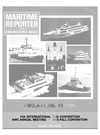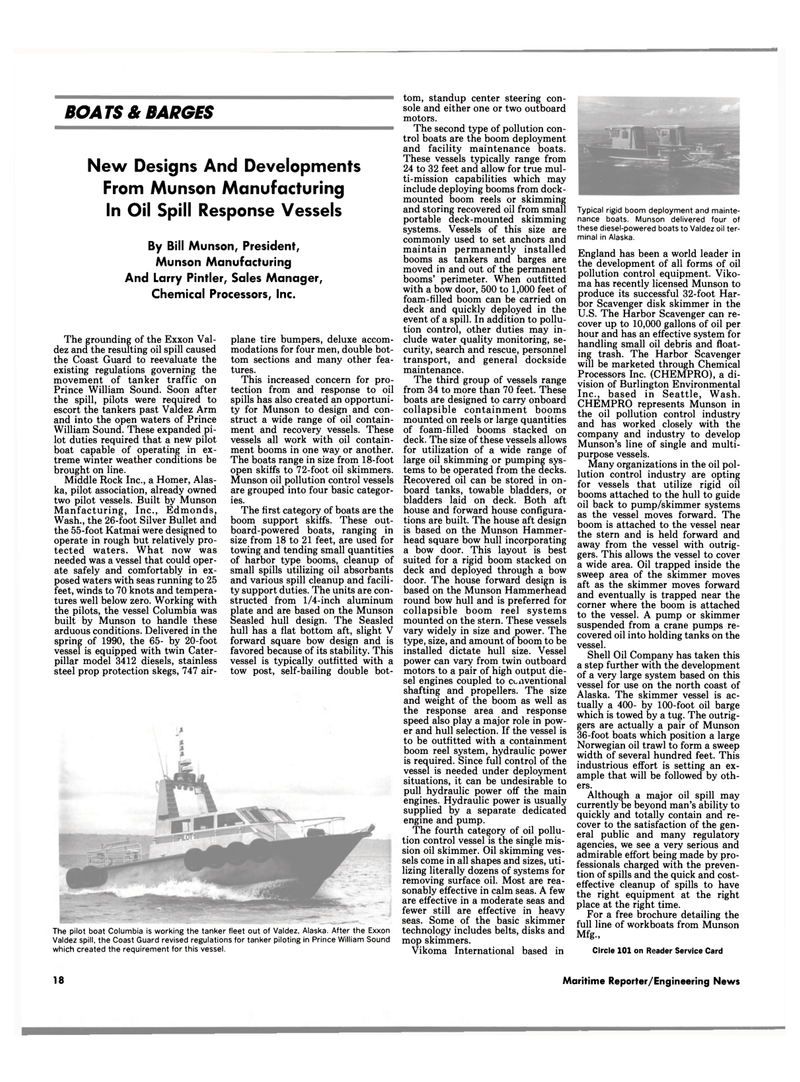
Page 16: of Maritime Reporter Magazine (August 1990)
Read this page in Pdf, Flash or Html5 edition of August 1990 Maritime Reporter Magazine
BOATS & BARGES
New Designs And Developments
From Munson Manufacturing
In Oil Spill Response Vessels
By Bill Munson, President,
Munson Manufacturing
And Larry Pintler, Sales Manager,
Chemical Processors, Inc.
The grounding of the Exxon Val- dez and the resulting oil spill caused the Coast Guard to reevaluate the existing regulations governing the movement of tanker traffic on
Prince William Sound. Soon after the spill, pilots were required to escort the tankers past Valdez Arm and into the open waters of Prince
William Sound. These expanded pi- lot duties required that a new pilot boat capable of operating in ex- treme winter weather conditions be brought on line.
Middle Rock Inc., a Homer, Alas- ka, pilot association, already owned two pilot vessels. Built by Munson
Manfacturing, Inc., Edmonds,
Wash., the 26-foot Silver Bullet and the 55-foot Katmai were designed to operate in rough but relatively pro- tected waters. What now was needed was a vessel that could oper- ate safely and comfortably in ex- posed waters with seas running to 25 feet, winds to 70 knots and tempera- tures well below zero. Working with the pilots, the vessel Columbia was built by Munson to handle these arduous conditions. Delivered in the spring of 1990, the 65- by 20-foot vessel is equipped with twin Cater- pillar model 3412 diesels, stainless steel prop protection skegs, 747 air- plane tire bumpers, deluxe accom- modations for four men, double bot- tom sections and many other fea- tures.
This increased concern for pro- tection from and response to oil spills has also created an opportuni- ty for Munson to design and con- struct a wide range of oil contain- ment and recovery vessels. These vessels all work with oil contain- ment booms in one way or another.
The boats range in size from 18-foot open skiffs to 72-foot oil skimmers.
Munson oil pollution control vessels are grouped into four basic categor- ies.
The first category of boats are the boom support skiffs. These out- board-powered boats, ranging in size from 18 to 21 feet, are used for towing and tending small quantities of harbor type booms, cleanup of small spills utilizing oil absorbants and various spill cleanup and facili- ty support duties. The units are con- structed from 1/4-inch aluminum plate and are based on the Munson
Seasled hull design. The Seasled hull has a flat bottom aft, slight V forward square bow design and is favored because of its stability. This vessel is typically outfitted with a tow post, self-bailing double bot-
The pilot boat Columbia is working the tanker fleet out of Valdez, Alaska. After the Exxon
Valdez spill, the Coast Guard revised regulations for tanker piloting in Prince William Sound which created the requirement for this vessel. torn, standup center steering con- sole and either one or two outboard motors.
The second type of pollution con- trol boats are the boom deployment and facility maintenance boats.
These vessels typically range from 24 to 32 feet and allow for true mul- ti-mission capabilities which may include deploying booms from dock- mounted boom reels or skimming and storing recovered oil from small portable deck-mounted skimming systems. Vessels of this size are commonly used to set anchors and maintain permanently installed booms as tankers and barges are moved in and out of the permanent booms' perimeter. When outfitted with a bow door, 500 to 1,000 feet of foam-filled boom can be carried on deck and quickly deployed in the event of a spill. In addition to pollu- tion control, other duties may in- clude water quality monitoring, se- curity, search and rescue, personnel transport, and general dockside maintenance.
The third group of vessels range from 34 to more than 70 feet. These boats are designed to carry onboard collapsible containment booms mounted on reels or large quantities of foam-filled booms stacked on deck. The size of these vessels allows for utilization of a wide range of large oil skimming or pumping sys- tems to be operated from the decks.
Recovered oil can be stored in on- board tanks, towable bladders, or bladders laid on deck. Both aft house and forward house configura- tions are built. The house aft design is based on the Munson Hammer- head square bow hull incorporating a bow door. This layout is best suited for a rigid boom stacked on deck and deployed through a bow door. The house forward design is based on the Munson Hammerhead round bow hull and is preferred for collapsible boom reel systems mounted on the stern. These vessels vary widely in size and power. The type, size, and amount of boom to be installed dictate hull size. Vessel power can vary from twin outboard motors to a pair of high output die- sel engines coupled to conventional shafting and propellers. The size and weight of the boom as well as the response area and response speed also play a major role in pow- er and hull selection. If the vessel is to be outfitted with a containment boom reel system, hydraulic power is required. Since full control of the vessel is needed under deployment situations, it can be undesirable to pull hydraulic power off the main engines. Hydraulic power is usually supplied by a separate dedicated engine and pump.
The fourth category of oil pollu- tion control vessel is the single mis- sion oil skimmer. Oil skimming ves- sels come in all shapes and sizes, uti- lizing literally dozens of systems for removing surface oil. Most are rea- sonably effective in calm seas. A few are effective in a moderate seas and fewer still are effective in heavy seas. Some of the basic skimmer technology includes belts, disks and mop skimmers.
Vikoma International based in
Typical rigid boom deployment and mainte- nance boats. Munson delivered four of these diesel-powered boats to Valdez oil ter- minal in Alaska.
England has been a world leader in the development of all forms of oil pollution control equipment. Viko- ma has recently licensed Munson to produce its successful 32-foot Har- bor Scavenger disk skimmer in the
U.S. The Harbor Scavenger can re- cover up to 10,000 gallons of oil per hour and has an effective system for handling small oil debris and float- ing trash. The Harbor Scavenger will be marketed through Chemical
Processors Inc. (CHEMPRO), a di- vision of Burlington Environmental
Inc., based in Seattle, Wash.
CHEMPRO represents Munson in the oil pollution control industry and has worked closely with the company and industry to develop
Munson's line of single and multi- purpose vessels.
Many organizations in the oil pol- lution control industry are opting for vessels that utilize rigid oil booms attached to the hull to guide oil back to pump/skimmer systems as the vessel moves forward. The boom is attached to the vessel near the stern and is held forward and away from the vessel with outrig- gers. This allows the vessel to cover a wide area. Oil trapped inside the sweep area of the skimmer moves aft as the skimmer moves forward and eventually is trapped near the corner where the boom is attached to the vessel. A pump or skimmer suspended from a crane pumps re- covered oil into holding tanks on the vessel.
Shell Oil Company has taken this a step further with the development of a very large system based on this vessel for use on the north coast of
Alaska. The skimmer vessel is ac- tually a 400- by 100-foot oil barge which is towed by a tug. The outrig- gers are actually a pair of Munson 36-foot boats which position a large
Norwegian oil trawl to form a sweep width of several hundred feet. This industrious effort is setting an ex- ample that will be followed by oth- ers.
Although a major oil spill may currently be beyond man's ability to quickly and totally contain and re- cover to the satisfaction of the gen- eral public and many regulatory agencies, we see a very serious and admirable effort being made by pro- fessionals charged with the preven- tion of spills and the quick and cost- effective cleanup of spills to have the right equipment at the right place at the right time.
For a free brochure detailing the full line of workboats from Munson
Mfg.,
Circle 101 on Reader Service Card 18 Maritime Reporter/Engineering News

 15
15

 17
17
